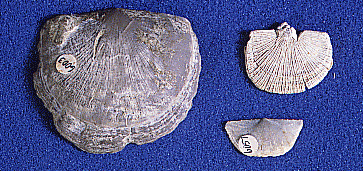The Strophomenida


The Strophomenida were the largest order of brachiopods, with about 400 genera. They were also by far the most morphologically diverse group, and included some very unusual forms, as well as more "normal" forms like those pictured above. Strophomenids first appeared in the Ordovician and persisted until the middle Jurassic.
Strophomenids may be identified by their supra-apically located pedicle foramen, at least in young shells. Adult strophomenids lacked an open pedicle foramen, and usually lived attached to the bottom or to other objects by the pedicle valve. One group of strophomenids, the productids, were characterized by very long spines extending from the shell. These are thought to have functioned as a sort of "snowshoe," supporting and stabilizing the organism on soft muds. Other strophomenids were attached to the bottom by a cone-shaped pdicle valve, with the upper valve covering the cone like a pot lid. The unusual brachiopod Prorichthofenia from the Permian of Texas is one of these unusual conical forms. This shape is convergent on that of other attached organisms, such as Paleozoic rugose corals and living scleractinian corals, and it is though that, like corals, some strophomenids bore photosynthetic algae inside their tissues that helped to supply them with food.
Williams, A. et al. 1965. Treatise on Invertebrate Paleontology. Part H, Volume 1: Brachiopoda. Geological Society of America and University of Kansas Press.


